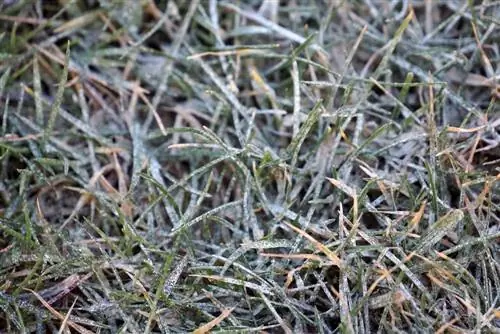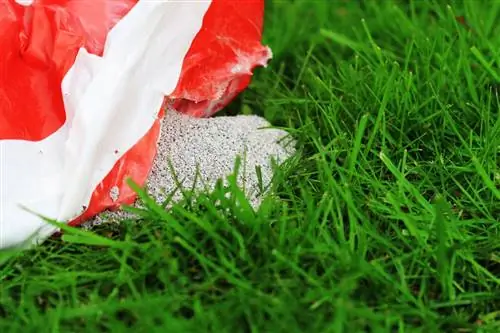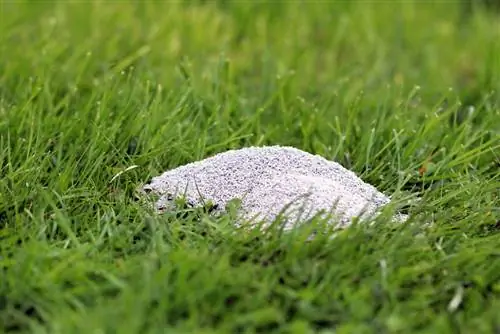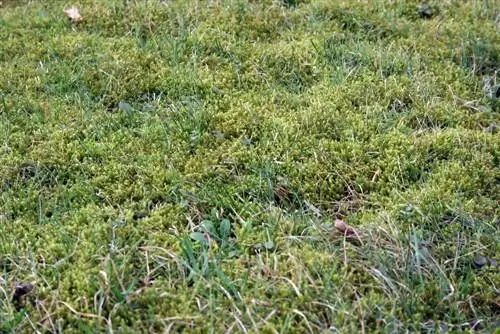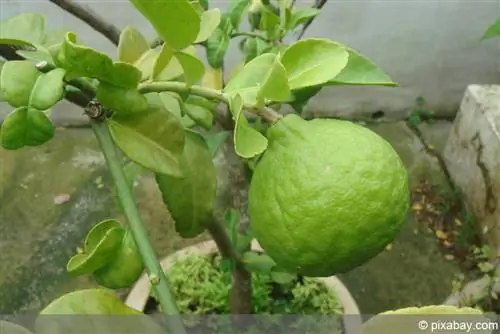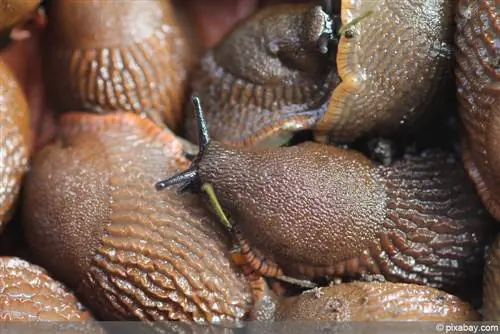- Author admin [email protected].
- Public 2023-12-17 03:39.
- Last modified 2025-01-24 12:45.
Whether the lawn is bright green and grows densely depends largely on the soil and its condition. If the substrate becomes more acidic and poor in nutrients over time, the grass will no longer grow well. With the help of dolomite lime, this problem can be solved immediately. However, a soil analysis should be carried out before spreading to determine the pH value and the amount of lime required.
Composition
Dolomite limestone occurs as a rock in the ground all over the world; the mining areas are not only in the Dolomites. Chemically speaking, the mineral belongs to the limestone group, but the type of rock is significantly harder and also more brittle. Since contact with acid results in a very delayed reaction for the mineral, it is ideal for acidic soils. Soil that is too acidic becomes compacted over time and the plants growing in it are no longer optimally supplied with nutrients. The use of dolomite lime also promotes the aeration of the soil and the circulation of water. Due to its composition, the mineral fertilizer is also an important source of nutrients for the garden.
- Difficultly soluble limestone
- Extracted from dolomite rock
- Is available as granular and ground mineral fertilizer
- Contains a lot of calcium and magnesium
- Also called carbonated lime
- Invigorates and activates the lawn
- Regulates acidity in the soil
- Develops its effect very slowly and gently
Application
The use of dolomite lime is particularly useful if the location of the lawn is in a region with a lot of acidic rainfall. The composition of the irrigation water from the tap also plays an important role; the limestone can compensate for water that is too soft with a low lime content. In this context, the mineral improves soil conditions and also acts as a fertilizer. In addition, it prevents the spread of moss, weeds and other unwanted plants in the lawn. If the soil is particularly rich in humus, the effectiveness improves sustainably. To ensure the correct dosage of mineral fertilizer, the soil should be examined before application. A professional soil analysis is ideal for this, as it provides precise information about the condition of the soil. If there are deficiencies and signs of fatigue in the soil, these can be compensated for with the help of dolomite lime.
- First prepare the soil adequately
- Remove moss pads, weeds and dead plant parts
- Remove stones and roots scattered in the lawn
- raking up wilted and dried leaves
- Dethatch the lawn before use
- Use a rake and spade to apply the product
- Wear gloves for protection
- Sprinkle mineral fertilizer holistically and over a wide area
- Then work well into the soil
- Mix with substrate to a depth of about 5-8 cm
- No deeper digging or lifting is required
- Works after just a few days
Use in the lawn
To improve the soil properties and structure, the lawn needs lime from time to time. Then the grass shines in a beautiful green for a long time and grows as a dense carpet. Above all, the magnesium contained in dolomite lime promotes a rich green tone as it sustainably supports the build-up of chlorophyll. The grasses also depend on the correct pH value in the soil. If the soil is too acidic, the lawn should be limed immediately. However, under no circumstances should the pH value permanently shift into an alkaline range. Therefore, a previous soil analysis is of great importance in order to determine the timing and amount of lime. After the first use of dolomite lime, moss and weeds disappear on their own, as these unwanted plants prefer highly acidic soils.
- PH values between 5.5 and 6.5 in the soil are optimal
- Dosage amount depends on the soil condition
- Approximately 8-18 kg should be spread per 100 square meters
- For light and sandy soils, 8 kg is sufficient
- Medium-heavy soils can handle up to 13 kg
- Heavy and clayey soils need up to 18 kg
- Dose he alth lime significantly higher
Note:
Ideally, the mineral is incorporated into the freshly dug area before the lawn grass is first sown.
The right time
In general, dolomite lime can be used all year round. However, spreading in the winter months when temperatures are below zero is not easy because the ground is often frozen. At the beginning of the growing season, the mineral fertilizer can take effect in an extremely short time and accelerate the growth of the lawn. The later in the year the lime is applied, the easier it is to combat the annoying moss. If it hasn't rained for a long time and the ground is extremely dry, then you shouldn't lime. Otherwise there is a risk that the lawn will dry out even further. In addition, the lime can cause unsightly burns to lawn grasses when exposed to direct sunlight.
- Conduct maintenance lime approximately every two to three years
- Sprinkle annually for extremely acidic soils
- Applying lime in spring is ideal
- Late summer and autumn are also possible
- When liming, the soil should be slightly dry
- A cloudy sky is ideal, with rain expected
- In rainy weather, the mineral dissolves immediately
- Water thoroughly after liming without rain
Tip:
The lime should not be applied as fertilizer at the same time as manure. Otherwise, the nitrogen contained in the manure suddenly escapes into the air without enriching the soil.

